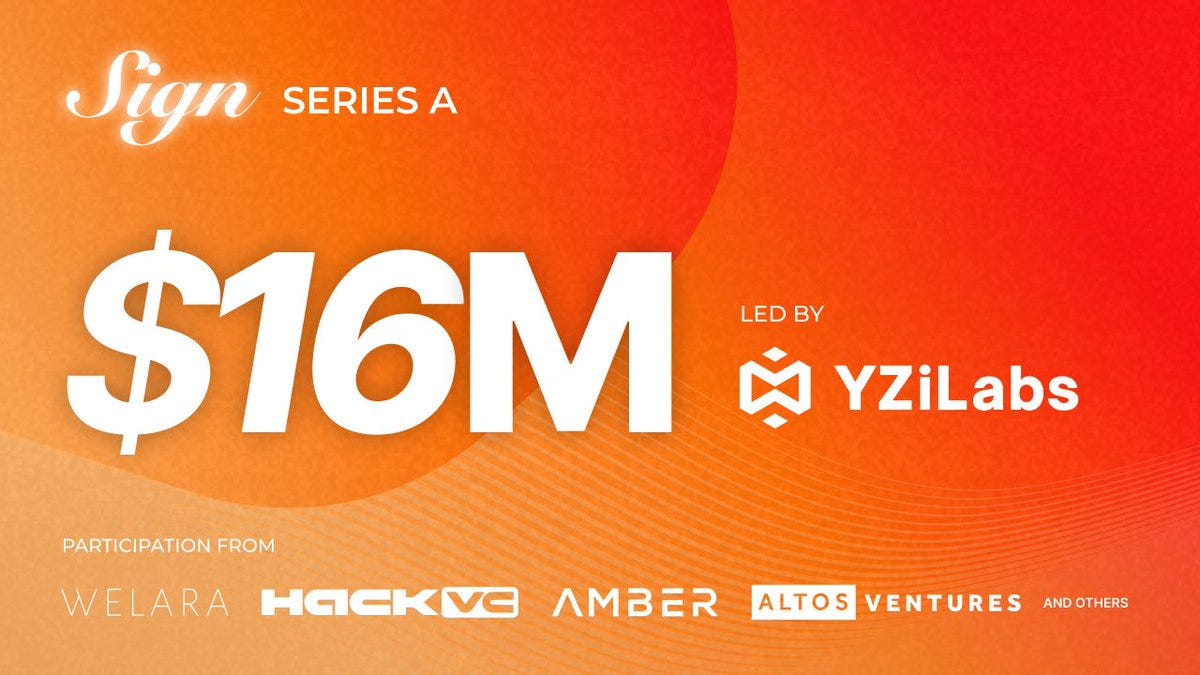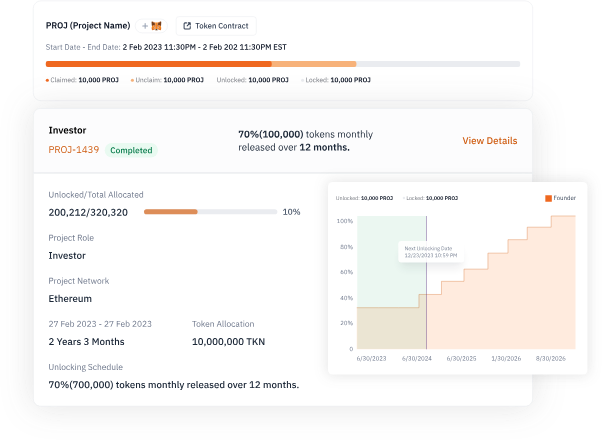Sign, The New Standard In The Web3 Ecosystem That Captures Both Community And Fundamentals
What Was The Orange Dynasty Built On?
This report was written by Tiger Research, analyzing Sign's success in building the "Orange Dynasty" community, its revenue-generating TokenTable infrastructure, and the vision for a trust-based Sign Protocol in the Web3 ecosystem.
TL;DR
Community: Sign has built a thriving "Orange Dynasty" community through cultural symbols (orange color and "SignGlasses"), a fair incentive structure using Soulbound Tokens (SBT), and continuous engagement. This community of over 50,000 members provides strong support.
Fundamentals: Sign generated $15 million in revenue in 2024 through TokenTable, a token distribution platform that has processed over $4 billion in token airdrops. The company has raised a total of $28 million from investors including YZi Labs and Sequoia Capital, demonstrating its strong position in the market.
Vision: Sign is expanding from TokenTable to the Sign Protocol, an identity verification system based on blockchain attestations. This system aims to solve issues like Sybil attacks while creating a programmable trust infrastructure with real-world applications in RWA, CBDC, and government partnerships.
1. Community in the Web3 Industry
Communities play an essential role in brand development. They offer members a sense of identity and belonging, creating emotional ties that strengthen loyalty. These bonds contribute to organic brand growth and resilience during periods of crises.
Community-building is not a new concept—it has long played a role in traditional industries. Lululemon scaled globally by fostering a fitness community of 13 million members. Users took it upon themselves to spread the brand values across markets. Harley-Davidson, facing intense competition from Japanese motorcycle brands in the 1980s, navigated a major business crisis by forming the Harley Owners Group (H.O.G.), a passionate fan community that helped rebuild the brand’s strength.
Community plays an even bigger role in the Web3 industry. Web3 operates on a culture-centric, collaborative foundation. In decentralized environments, participants unite around shared beliefs and values rather than centralized authority. Community members are not just consumers—they often act as voluntary contributors and builders, amplifying the importance of community in a project’s success.
Academic research reinforces this point. Gartner & Moro (2024) analyzed data from 3,644 ICOs and found a strong correlation between social media followers on platforms like Twitter and Telegram and the likelihood of reaching fundraising targets.
In contrast, traditional indicators of professionalism, such as management team education and experience, showed minimal impact on success. This suggests that in the Web3 ecosystem, community support and engagement are stronger predictors of success than conventional credentials. Projects with high online visibility and active community support are better positioned to achieve their investment goals and sustain long-term growth.
2. Community: How Was the Orange Dynasty Built?
While many Web3 projects emphasize community in theory, few succeed in practice. Most projects concentrate on initial incentives or large side events and fail to create a culture that participants can genuinely connect with.
Three key elements are essential for building a sustainable Web3 community:
Cultural symbols that establish a sense of identity and belonging,
A fair incentive structure that motivates participation, and
Ongoing activities and communication channels that keep members engaged.
A real community emerges when these elements come together organically and reinforce one another.
Sign offers a strong example of this approach. Its community, known as the “Orange Dynasty,” is unified by a distinct identity built through consistent use of color and language
2.1. A cultural symbol for a strong sense of identity and belonging
The orange color adopted by the community has evolved beyond a brand element—it now functions as a cultural code. Psychologically associated with energy and passion, it has brought vitality to the group and taken shape as a distinctive symbol known as "SignGlasses," a stylized pair of sunglasses representing the community’s identity.
On X, users can become part of the community through simple visual tweaks—adding an orange background or incorporating sunglasses into their profiles—without fully altering their personal brand. This low barrier to entry has encouraged voluntary participation, fostering a strong sense of solidarity and contributing to the community’s organic growth.
2.2. Fair incentive structure to encourage participation
Sign’s second key strength lies in its unique incentive structure, which assigns value to meaningful contributions through a non-transferable token system known as the Soulbound Token (SBT).
What sets this system apart is its emphasis on qualitative engagement rather than surface-level metrics. Instead of rewarding volume—such as post counts or likes—Sign recognizes authentic participation and value creation. The SBT is divided into four categories and cannot be traded, which helps prevent manipulation and ensures that individual recognition is earned, not bought.
2.3. Activities and communication channels to keep people engaged
The final success factor is continuous communication and activity. With over 14,500 posts and more than 560 hours of X Space operations, Sign demonstrates its passion through these metrics.
The final success factor is continuous communication and engagement. Sign proves its passion through over 14,500 posts and more than 560 hours of X Space sessions.
One of the most notable aspects is that the project’s official presence on X is not centralized under the @sign handle. Instead, it is operated by community accounts. This structure allows new users to encounter the project through community-driven content, offering initial exposure to the culture and values of Sign before exploring its core mechanics.
Through these communication strategies, Sign has cultivated a self-sustaining community of over 50,000 members. The depth of affiliation is evident—some members have even tattooed the Sign logo, a striking display of loyalty that reflects the project’s cultural impact.
3. Fundamentals: TokenTable's Tangible Achievements
Community strength alone is not enough—long-term sustainability requires tangible products and a clear vision. In 2024, Sign generated over $15 million in revenue through its token distribution platform, ‘TokenTable’. This level of revenue is rare in the Web3 space and provides a solid foundation that supports and reinforces the community.
These results have attracted investor attention. Sign has raised a total of $28 million in funding to date. The company secured $12 million in its seed round and raised an additional $16 million in a Series A round led by YZi Labs (formerly Binance Labs) under CZ's leadership in January 2025.
Particularly noteworthy is that all three divisions of Sequoia Capital—US, China, and India/Southeast Asia—participated in the seed round. Sequoia typically invests through a single regional division, making Sign a rare exception. The cross-regional participation reflects broad confidence in Sign’s global potential.
3.1. TokenTable Now
TokenTable has positioned itself as the Web3 equivalent of Goldman Sachs. Just as Goldman Sachs manages stock issuance, investor onboarding, and market making in traditional finance, TokenTable serves as core infrastructure for token issuance, distribution, and liquidity management in the blockchain ecosystem.
The complexity and risk involved in token operations explain why such services are critical in the Web3 ecosystem. Writing and auditing smart contract code for token issuance requires specialized expertise. Distributing tokens to tens of thousands—or even millions—of users is technically demanding, where small errors can result in significant losses. Managing lockup schedules for investors and team members also requires transparency and precision, as manual processes increase the risk of errors or misconduct.
TokenTable addresses these challenges by offering standardized infrastructure that simplifies the process. This enables project teams to focus their efforts on tokenomics and product development, rather than operational risk.
Token Airdrop Management: Enables automated distribution of tokens to community users. For example, Kaito used the platform to airdrop tokens to over 100,000 users.
Token unlock management: Uses smart contracts to schedule when investors or team members can unlock their tokens. Projects including Starknet, Dogs, and Zetachain employ TokenTable's Unlocker to handle this process transparently and securely.
OTC trade brokerage: Facilitates bulk token trading by transferring withdrawal rights for tokens that are still locked. This is comparable to direct apartment sales—allowing large token volumes to change hands safely without causing price disruptions on centralized exchanges.
TokenTable’s client portfolio includes major names such as Starknet, ZetaChain, DOGS, Mocaverse, and TON-based projects like Notcoin and GAMEE. In the TON ecosystem alone, TokenTable has distributed over $2 billion in assets to 40 million users.
3.2. TokenTable in 2025
TokenTable’s main revenue streams come from airdrop claim fees and OTC service fees. To date, the platform has processed over $4 billion in token airdrops and unlockings, connecting more than 40 million users and investors.
Demand for TokenTable’s services is not limited to large-scale projects. With the rise of token launchpads, the number of small-scale Web3 projects is growing rapidly. By 2027, an estimated 1.9 million projects are expected to enter the market—many of which will conduct airdrops or require structured token management. As a result, TokenTable’s potential customer base is expected to expand significantly in the coming years.
TokenTable Lite: A simplified version designed for projects with fewer than 100,000 users. It requires no approval and features an intuitive UI and streamlined setup process, making it accessible for anyone looking to create and distribute memecoins, fan tokens, or AI agent tokens.
TokenTable Dashboard: A transparency tool for investors, providing real-time on-chain data on token allocations and distribution schedules. It shows how tokens are distributed across stakeholders, exchanges, and wallets—beyond what is disclosed in project whitepapers.
FutureToken technology: A next-generation derivative tool that evolves the OTC trading model. Rather than simply transferring withdrawal rights, it creates standardized financial instruments based on locked tokens that can be freely traded on secondary markets. This is similar to converting an apartment lease into security and trading it on a stock exchange, improving investor protection, reducing information asymmetry, and increasing secondary market liquidity.
These product extensions are designed to support broader adoption, lower barriers for new projects, and unlock additional revenue streams. Backed by both a loyal community and a scalable revenue model, Sign is well-positioned for long-term growth.
4. Vision: Trust-Based Sign Protocol
Sign is now expanding its focus from TokenTable to a broader identity verification system. While TokenTable effectively connects token distribution with investors, it faces a key limitation: the lack of connection between digital wallet addresses and real user identities.
This gap makes it difficult to address issues such as Sybil attacks. If wallets could be reliably linked to individual users, it would be possible to detect and prevent attempts to claim airdrops using multiple accounts. At present, these efforts rely on analyzing wallet interactions to infer suspicious behavior. Although blockchain systems are designed to operate without trust, there are cases —particularly in airdrop distribution or governance—where understanding what exists behind an address becomes necessary.
Recognizing this challenge, Sign developed the Sign Protocol—a trust system designed to enable easy and reliable identity verification across both physical and digital spaces. At its core is the concept of “attestation”: the process of digitally confirming and recording that a specific piece of information or claim is genuine, allowing others to verify its authenticity at any time.
For example, when a government confirms that “this person is a citizen of a specific country,” this information can be digitally signed and recorded on-chain. Once stored this way, it becomes easily verifiable by other institutions and services. The Sign Protocol organizes these attestations using standardized templates called “Schema”s—similar to how passports or ID cards follow a consistent format for managing identity data.
This system has significantly improved the user experience. Instead of repeating KYC procedures across multiple platforms, users can reuse attestations created once through the Sign Protocol. While the initial use case focused on airdrop eligibility and Sybil attack prevention, the framework opens possibilities in broader domains where verified identity or qualification is required—notably in Real-World Assets (RWA) and Central Bank Digital Currencies (CBDCs).
RWA is a concept that converts physical assets like real estate or stocks into digital tokens for blockchain trading. In this space, regulatory compliance is essential. With verified investor qualifications managed through Sign Protocol, the investment process can be streamlined. As real-world assets move on-chain, corresponding DeFi applications are expected to grow organically.
In parallel, CBDC distribution presents another key use case. When governments aim to distribute digital currency at scale, combining TokenTable’s large-scale distribution capabilities with Sign Protocol’s identity verification infrastructure enables efficient and secure rollouts.
However, for Sign’s attestations to evolve into true trust infrastructure, they must move beyond simple on-chain claims—they must be recognized by real-world institutions and systems. To this end, Sign has already demonstrated tangible results:
In Sierra Leone, the team built blockchain-based digital ID cards, issuing the world’s first on-chain verifiable physical identification.
In the UAE, they partnered with the government of Ras Al Khaimah to automate public administration processes using blockchain.
Through collaboration with Cypher Capital and RAK DAO, they launched a 10-year residence visa program for Web3 entrepreneurs.
These milestones demonstrate that Sign is not only building technical infrastructure—it is actively forging real-world trust.
Ultimately, Sign represents more than a verification tool. It is laying the groundwork for a future architecture of trust, guided by the vision of “defining trust and making it programmable.” As the Web3 ecosystem matures, this foundational capability will become increasingly indispensable.
5. Sign: Community, Fundamentals, and Vision
Sign is a model project in the Web3 ecosystem that has successfully built both a community and a business foundation in parallel. Unlike many token-driven projects that raise funds before launching products, Sign is expanding its ecosystem around TokenTable—a product with a proven revenue model—demonstrating an execution-first approach.
While the Sign Protocol remains in its early stages, the team has shown strong operational capability through government partnerships, including ID card and crypto card development. These achievements serve as concrete indicators of feasibility and long-term sustainability, going beyond abstract vision statements.
At the same time, Sign faces challenges in scaling its ecosystem with only internal resources. To convert current community enthusiasm into sustained growth, the project will need to foster external builders aligned with its goals. This requires a strategy to expand the ecosystem around the project’s strong cultural foundation, enabling third-party services to develop on top of the Sign Protocol.
Despite these hurdles, Sign is widely viewed as a project with significant long-term potential, backed by both business traction and a loyal community. If the team succeeds in scaling the Sign Protocol into a broader ecosystem—built on the proven success of TokenTable—it may offer a new blueprint for sustainable Web3 growth.
🐯 More from Tiger Research
Read more reports related to this research.Disclaimer
This report was partially funded by Sign. It was independently produced by our researchers using credible sources. The findings, recommendations, and opinions are based on information available at publication time and may change without notice. We disclaim liability for any losses from using this report or its contents and do not warrant its accuracy or completeness. The information may differ from others' views. This report is for informational purposes only and is not legal, business, investment, or tax advice. References to securities or digital assets are for illustration only, not investment advice or offers. This material is not intended for investors.
Terms of Usage
Tiger Research allows the fair use of its reports. ‘Fair use’ is a principle that broadly permits the use of specific content for public interest purposes, as long as it doesn't harm the commercial value of the material. If the use aligns with the purpose of fair use, the reports can be utilized without prior permission. However, when citing Tiger Research's reports, it is mandatory to 1) clearly state 'Tiger Research' as the source, 2) include the Tiger Research logo following brand guideline. If the material is to be restructured and published, separate negotiations are required. Unauthorized use of the reports may result in legal action.













